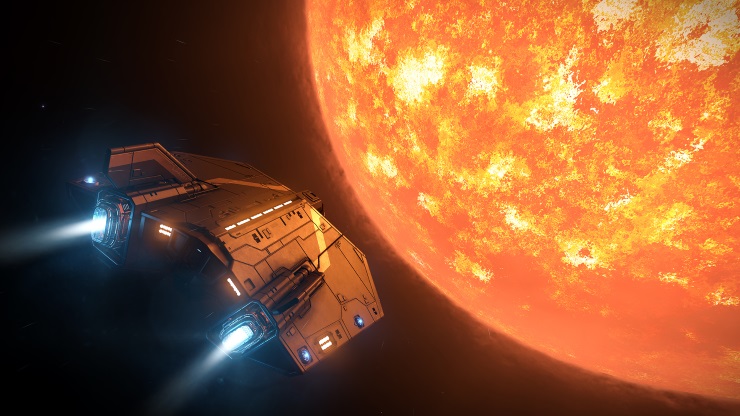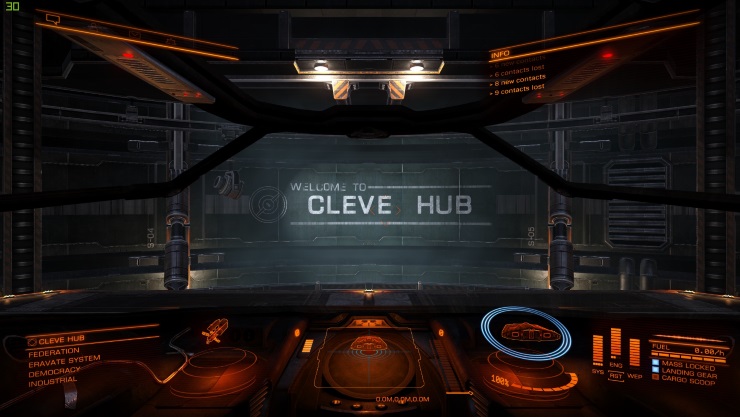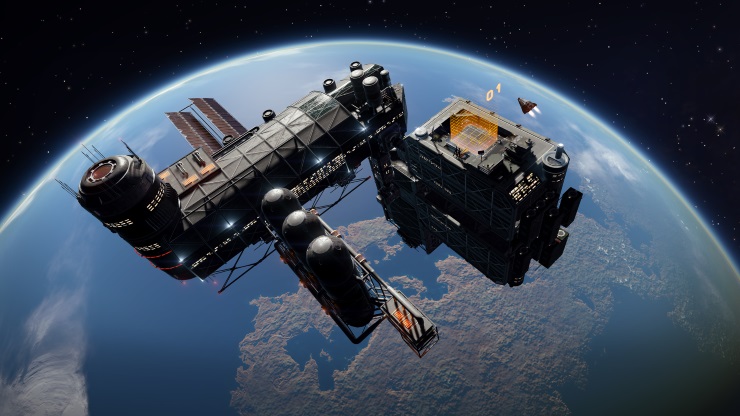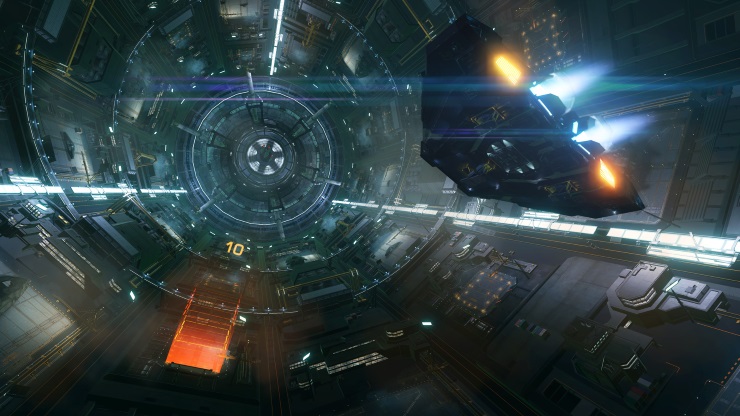October 6, 2015.
Elite: Dangerous is not an easy-going game, at least for the first few hours. And even after that, it doesn’t actually become any simpler or more accessible; it’s just that you learn to adapt to its environments and accept that, if you want to get the most out of it, you’re going to need to play by a very particular set of rules. As a space exploration, trading and combat “sim”, Elite: Dangerous is pretty close to the top of a relatively small pile. Having never really delved deeply into EVE Online or Star Citizen I can’t honestly compare them to Frontier’s game, but by all accounts, ED is a tremendous feat of game design that manages to thrill and frustrate in equal measure.
Having been enjoyed for several years now by the PC massive, Elite: Dangerous has now frame-shifted its way onto Xbox One, but comes with an almost arrogant swagger. It seems to delight in explaining very little and presenting you with a double-edged freedom. For example, right from the off you can go anywhere you want in the galaxy – but you’ll need to work out what to do when you get there. With no driving narrative or even a framework for personal stories like a more traditional MMO, Frontier’s space adventure takes pleasure in throwing you in at the deep end.

Technically an early access game, the Xbox One version is still very much an ever-changing beast, and updates and patches are forever on the horizon. For now, though, what we have is, to all intents and purposes, a complete game. A sandbox in the truest sense, Elite: Dangerous starts you off with a simple ship, a limited supply of cash, and the instruction to get on with it. Delving into the tutorials, I immediately felt overwhelmed, a feeling that never really dissipated. Even the training missions are tough, and the first time I went up against a similarly-matched AI enemy I failed three times in a row before moving on. Very little is explained, and in fact the training menu directs you to linked YouTube instructionals. It’s almost as if Frontier expect that anyone playing the Xbox One version is transitioning over from PC. Either that, or learning by doing is an intended part of the process.
Combat is similar to any flight sim. Once a target is located, the dogfight commences, and will see you evading, tailing and boosting into and out of danger as you attempt to whittle down the enemy’s shields to land the killing shot. In Elite: Dangerous, combat can feel exhaustive at first. Both your shield and your opponents take a while to wear down, and then clever evasion will see it recharge fairly quickly. On the one hand, it makes encounters last a little too long, while on the other hand it turns every dogfight into a real challenge that feels hard-fought-for when you win, and honest when you lose. There are times, particularly in the multiplayer mode, when you’ll come across opponents who are vastly superior to you, but you don’t have to fight anyone, and running away is always a viable option.

The variety of weapon and utility loadouts is impressive, mixing missile racks with lasers, railguns, torpedos and gatling cannons, while furnishing you with flak launchers, heat sinks and deflectors among a huge pile of other options. You can also boost your damage mitigation, speed, firepower and utility tools (cargo scoops and such) by purchasing upgrades in the various spaceports dotted around the galaxy. Of course, this costs money, which means you need to work, and that’s where Elite: Dangerous really opens up for you.
There’s a huge selection of jobs, selectable from bulletin boards in spaceports or by investigating signals out in the big black. The jobs range from assassination missions to simple courier assignments, but they run the gamut of escort missions, cargo salvage, exploration, interception and combat, with varying degrees of legality. Part of the beauty of Elite: Dangerous is that you can play your own way, so if you choose to be a slave-trading, cargo-smuggling space pirate, you can be – or you could be the straight-laced mercenary that hunts such criminals down. Everything affects the shared world, and your actions will have consequences. If you’re going to trade in slaves, be prepared for other players to come looking for you, either to shut you down for the greater good or to steal your business interests.
Presented in first person, the UI performs the titanic task of cramming everything accessible on a keyboard onto the Xbox One controller. As a result, there are lots of menus and sub-menus, but there’s something effortlessly cool about looking around the interior of your cockpit to activate various systems. You can monitor everything on the fly, from your ship status to current mission parameters, your level of favour with the three factions (named the Alliance, the Empire and the Federation in a nod to pretty much every major sci-fi franchise going), your cargo and weapons systems, and your communications array. You can even alter certain options from the cockpit, adding a layer of immersion by not forcing you to pause the game to, say, change the behaviour of your targeting crosshair. The D-Pad is your best friend, and holding down each face button will open a different menu, where simply tapping the button instead will perform a mapped action. It sounds complicated, but it leaves the shoulder buttons and sticks free for pitching, yawing, shooting and boosting.

The starting ship, the Sidewinder, will do you proud for a spell, but later you’ll need to switch it out occasionally for different models with varying functions and stats. The bulky Hauler, for example, has a huge cargo hold, which is handy for particular missions even if its reduced maneuverability can leave you worryingly open to pirates. Getting caught up in a massive space battle in one of those isn’t much fun, but engaging in a similarly sized free-for-all in a smaller fighter ship is about the most exhilarating experience you can have in gaming – especially if you’re at least a few hours in and you’ve mastered the controls and the art of power distribution (that is, flicking the D-Pad to bolster speed, firepower or shields on the fly, while reducing the other two functions accordingly).
If Elite: Dangerous has a single major issue, it’s that the flip-side to such dazzling action is the numbing emptiness that comes between. The galaxy is beyond vast, and there are hundreds of ports to travel to and from. While it feels cool to boost to hyperspace (the boom of your Frame Shift drive is powerful and effortlessly impressive), the actual act of travelling is dull. Space is empty and lonely, and when you’re not engaged in something, all you’re doing is looking at the big open sky and it’s easy to feel disconnected. Keeping busy is the key to really enjoying Elite: Dangerous, but that can occasionally make the whole experience feel like hard work. It’s not all about combat, of course, and it can be just as enjoyable to become a smuggler, miner or deep-space courier. The choices aren’t endless, but they’re myriad enough to fool you into thinking they are. You can simply go about your business, working an honest job for honest pay, while the three factions war around you. If you don’t want to get involved, you don’t have to – although every reward is worth the risk, and war is highly lucrative.

Luckily, what there is to see is beautiful. Distant nebulas and nearer worlds look incredible, and orbiting a space station while you wait for docking permission provides a genuine sense that you are a tiny, tiny little cog in a gargantuan machine. Finding yourself in one of the aforementioned free-for-all battles around a massive, gently spinning station is intoxicating, especially if you make it out alive. Very few moments in gaming elicit such energetic air-punching, but it’s another example of the hot/cold attitude Elite: Dangerous has towards its players. Amazing things are promised for the future, as Frontier have revealed semi-solid plans for on-foot exploration and indoor action. If even half of their plans come to fruition, they may have a genuine world-beater on their hands.
Given its breadth and scope, Elite: Dangerous is something of a marvel, but size isn’t everything. This is hardcore stuff, in many ways, and not something to be taken lightly. It will eat hours and hours of your life and the progress you make will seem slow and uneven, while it’s worryingly easy to get stuck in a cycle of doing not very much at all and growing bored until the next dogfight. That being said, there’s a lot of joy to be had simply exploring the galaxy, it’s frighteningly accurate scale reminding you the whole time just what a tiny mote you are in the grand scheme of things. It won’t appeal to everyone, but if you want an experience that feels unique, a rare degree of freedom, and the opportunity to fly really fast and blow up other ships should the mood take you, Elite: Dangerous comes highly recommended – just don’t go in expecting an arcadey blaster or a free ride. You’ll find neither here.
Absolutely huge.
Very atmospheric.
Incredible sense of freedom.
Too hardcore for some.
Periods of nothingness.
Very little is explained or contextualised.
Elite: Dangerous is a well-made space sim with incredible scope and wondrous plans for the future, but it might put off some players with its complexity.



